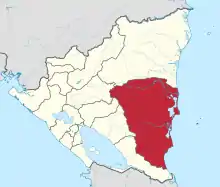Pearl Lagoon
Pearl Lagoon is a town in the municipality by the same name and was historically known as English Bank.[1] It is located in the South Caribbean Coast Autonomous Region of Nicaragua. It is the largest coastal lagoon in the South Caribbean Coast Autonomous Region. Pearl Lagoon is home to 8,658 inhabitants as of 2005.
Pearl Lagoon | |
|---|---|
Municipality | |
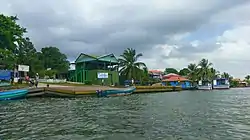 Municipal wharf of Pearl Lagoon | |
 Flag  Coat of arms | |
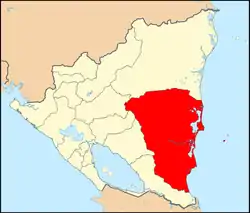 | |
| Coordinates: 12°21′N 83°40′W | |
| Autonomous Region | South Caribbean Autonomous Region |
| Government | |
| • Type | Mayor |
| • Mayor | Dariel Taylor |
| Area | |
| • Total | 1,963 km2 (758 sq mi) |
History
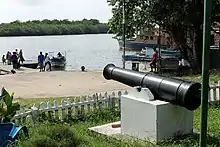
Pearl Lagoon, along with the eastern half of present-day Nicaragua, was a British protectorate from 1655 until 1860, a period when the region was called the Mosquito Coast.
In the period before 1894, eastern Nicaragua was a British protectorate, ruled through a line of Miskito kings. About a century ago, Pearl Lagoon was considered to be the second capital of the Miskito Kingdom when the last Miskito king took up residence in the city. He arrived there after Henry Clarence deposited him in Bluefields in 1894.
At that time, Pearl Lagoon was called "the Granada of the Mosquitia" by one of the conquistadores of the Pacific Coast (the Caribbean side was not then a part of Nicaragua) because of its beauty and the booming ship traffic.
An 18th century cannon situated in the main street of the city has an inscription commemorating battles between liberal and conservative factions.[2] The cannon was never fired in anger, it was used only for celebrations.
Culture
Most of the inhabitants are Creole, but a large number of Miskito, Mestizo and some Garifuna are also present. The Mestizo people started migrating in the late 90s, some from the city of El Rama and some from the northern part of the municipality of Pearl Lagoon.
Similar to Bluefields, May Pole is a big celebration among the people. Now within the same month of May, people from all over the municipality would come together in the community of Pearl Lagoon to celebrate and share their different cultures and traditions.
The most traditional dish in the community is best known as, Rondon. The people are also well known for their delicious coconut bread, which is also something that is sell on a daily basis for the income of many.
The main communities are Haulover, Kakabila, Marshall Point, Pearl Lagoon, Orinoco, La Fe, Raitipura, Brown Bank, Tasbapauni, Set Net Point, Wawashan, San Vicente, Awas and Pedregal.[3]
Sports

Pearl Lagoon was the home to four local baseball teams that played during the dry seasons on Sundays. The four teams were: Sweet Pearly, First Stop, The Young Brave, and the Haulover Tigers.[4] Pitchers Albert Williams and Devern Hansack, both natives of Pearl Lagoon, who played in the Major League Baseball. Even though those teams no longer exist, baseball is still one of the main sport in the community which is also play in dry season on Sundays at the Harry and Maggie Taylor municipal stadium.
On the 26th of May 2012 there was a meeting held in the municipal stadium amongst leaders of the Caribbean Coast who were concern and were willing to support in the rebuilding of the stadium for the Atlantic baseball series that took place in 2013 in which Pearl Lagoon was the champion. Before that time baseball games only took place at day time, but after the great reconstruction the stadium now has its own night LED bulbs that gives players the opportunity to hit a homerun at night. Until this day the Harry and Maggie Taylor municipal stadium is still one of the greatest achievement for the people of the community.
Transportation
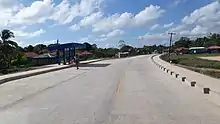
The municipality of Pearl Lagoon is located just north of Bluefields, the capital of the South Caribbean Coast Autonomous Region, and can be reach by boat and Panga boat.
In 2006, the IDR initiated the construction of a new rural road of 17 km from Kukra Hill to Pearl Lagoon. The road is now reconstructed and as of today, it permits direct access to Managua from Pearl Lagoon[5] and was financed by the World Bank (WB) through the International Development Association (IDA).
For more than 10 years, there has been a bus that travels every day from Pearl Lagoon to Kukra Hill and back. Around three years ago, the owner of that same bus started a new destination directly from Pearl Lagoon to Managua one time per week. These two buses are now known as the Ow transport whose owner is also a native from Pearl Lagoon by the name of Jasper Ow.
Education
In Pearl Lagoon, there are three schools. The Beulah Light Burn school which is only for primary and pre-escolar students, the Pearl Lagoon National Institute only for Secondary students and the Pearl Lagoon Academy of Excellence (PLACE) for pre-escolar, primary and secondary students.
References
- Baracco, Luciano (2011). National Integration and Contested Autonomy: The Caribbean Coast of Nicaragua. ISBN 9780875868233.
| Wikimedia Commons has media related to Pearl Lagoon, Nicaragua. |
